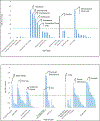Genome-wide association analyses identify 39 new susceptibility loci for diverticular disease
- PMID: 30177863
- PMCID: PMC6168378
- DOI: 10.1038/s41588-018-0203-z
Genome-wide association analyses identify 39 new susceptibility loci for diverticular disease
Abstract
Diverticular disease is common and has a high morbidity. Treatments are limited owing to the poor understanding of its pathophysiology. Here, to elucidate its etiology, we performed a genome-wide association study of diverticular disease (27,444 cases; 382,284 controls) from the UK Biobank and tested for replication in the Michigan Genomics Initiative (2,572 cases; 28,649 controls). We identified 42 loci associated with diverticular disease; 39 of these loci are novel. Using data-driven expression-prioritized integration for complex traits (DEPICT), we show that genes in these associated regions are significantly enriched for expression in mesenchymal stem cells and multiple connective tissue cell types and are co-expressed with genes that have a role in vascular and mesenchymal biology. Genes in these associated loci have roles in immunity, extracellular matrix biology, cell adhesion, membrane transport and intestinal motility. Phenome-wide association analysis of the 42 variants shows a common etiology of diverticular disease with obesity and hernia. These analyses shed light on the genomic landscape of diverticular disease.
Conflict of interest statement
Conflict of Interest Statement: No, I declare that the authors have no competing financial or non-financial interests as defined by Nature Research.
Figures




References
-
- Painter NS & Burkitt DP Diverticular disease the colon, a 20th century problem. Clin Gastroenterol 4, 3–21 (1975). - PubMed
-
- Sugihara K et al. Diverticular disease of the colon in Japan: A review of 615 cases. Dis Colon Rectum 27, 531–7 (1984). - PubMed
-
- Pan G, et al. Diverticular disease of the colon in China. Chin Med J 97, 391–4. (1984). - PubMed
-
- Alatise OI et al. Spectrum of colonoscopy findings in Ile-Ife Nigeria. Niger Postgrad Med J. 19, 219–24 (2012). - PubMed
Publication types
MeSH terms
Grants and funding
LinkOut - more resources
Full Text Sources
Other Literature Sources
Medical

